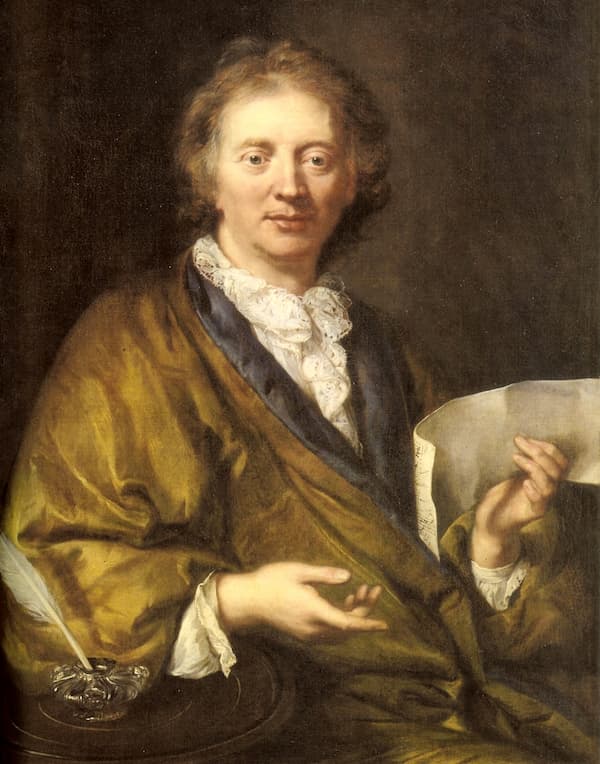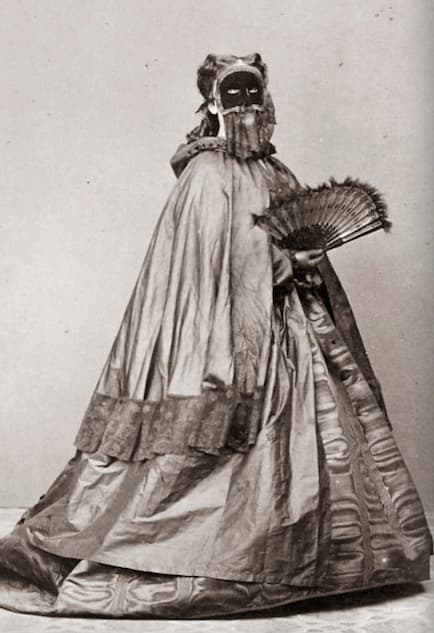François Couperin (188–1733) ranks with J.S. Bach and Dominico Scarlatti as one of the most prolific harpsichordists of his time. He was known as Couperin the Great, to differentiate him from the multiple other members of the Couperin family. His father and uncle were famous organists at the Church of Saint-Gervais in Paris, a position that François would inherit when he turned 18. At age 24, Couperin the Great was at the French court as organist to King Louis XIV.

Anonymous: François Couperin, first half of 18th century (Chateau de Versailles)
In 1713, he applied for a printing privilege for his harpsichord pieces and immediately published his first volume of works. His four books of harpsichord music, published between 1713 and 1730, contain over 230 individual pieces. His third book, published in 1722, included as the 13th ordre (cycle) a set of pieces entitled Les Folies françoises, ou Les Dominos, based on the Spanish La folia theme. This was probably originally a dance, and it survived as two eight-bar phrases and a melody.
In his 12-part ordre, Couperin gives us an interesting group of figures representing various sentiments of love: La Virginité, La Pudeur, L’Ardeur, L’Espérance, La Fidelité, La Persévérance, La Langueur, La Coquetterie, Les Vieux Galants, Les Coucous Benevoles, La Jalousie Taciturne, La Frénésie, ou Le Désespoir (Virginity, Modesty, Ardor, Hope, Fidelity, Perseverance, Languor, Coquetry, Old Gallants, Benevolent Cuckoos, Taciturn Jealousy, Frenzy or Despair). Each of these figures is assigned a domino colour.
At the French court, a domino was not merely a facial mask but also a cloak. Worn together, they hid the wearer’s identity and clothes. In the example below, dating from the 1860s, the mask includes a man’s beard!

Domino Cloak and Mask, 1860s
Couperin takes through all colours of the domino, from the invisible (for the virgins) to black, for those who have been left behind and are in either Frenzy or Despair.
François Couperin: Pieces de clavecin, Book 3: 13th Ordre in B Minor: Les Folies francoises, ou les Dominos: No. 1. La Virginite sous le Domino couleur d’invisible (Patrick Cohën-Akenine, harpsichord)
Pink is for Modesty
Red for Ardor with a correspondingly quickened tempo.
François Couperin: Pieces de clavecin, Book 3: 13th Ordre in B Minor: Les Folies francoises, ou les Dominos: No. 3. L’Ardeur sous le Domino incarnat (Patrick Cohën-Akenine, harpsichord)
Green is for Hope
Blue is for Fidelity
Linen grey is for Perseverance
Violet for Languor
François Couperin: Pieces de clavecin, Book 3: 13th Ordre in B Minor: Les Folies francoises, ou les Dominos: No. 7. La Langueur sous le Domino Violet (Patrick Cohën-Akenine, harpsichord)
Coquetry, on the other hand, can appear in different colours
Purple dominoes and dominos, the colour of dead leaves, are the provenance of The Old Gallants and the Outdated Treasures
François Couperin: Pieces de clavecin, Book 3: 13th Ordre in B Minor: Les Folies francoises, ou les Dominos: No. 9. Les Vieux galans et les Tresorieres suranees sous des Dominos pourpres, et feuilles mortes (Patrick Cohën-Akenine, harpsichord)
Yellow is for the ‘benevolent cuckoos.’
A dark grey is for silent jealousy
And finally, black is for Frenzy and Desperation
François Couperin: Pieces de clavecin, Book 3: 13th Ordre in B Minor: Les Folies francoises, ou les Dominos: No. 12. La Frenesie, ou le Desespoir sous le Domino noir (Patrick Cohën-Akenine, harpsichord)
These colours are not chosen randomly. Within the French court, these colours had symbolic values. Let’s look at these again.
We can leave aside the transparency of virginity, as it is no colour. Pink (modesty) is associated with fragility. Red (or as it’s given here, ‘incarnation’ for ardour) is the skin’s visible sign of passion. Green (hope) is Spring coming to life. Blue (fidelity) stands for both coldness and purity. Linen grey (perseverance) is an ambiguous colour as our lover looks for a response. Violet (languor) is the colour for alchemy, i.e., the science of transformation and therefore languor transforming into desire. Coquetry takes as many colours as required for flirting. The purple and ‘dead leaves’ (old gallants and outdated treasures) are the colours of dawn (‘when the spirits fail’) and of autumn (‘when life ebbs away’). Yellow (benevolent cuckoos) recalls the form that Zeus took when he seduced Hera, transforming into the bird which she had caught to be her pet. Yellow is the colour of the sun, of the new day, and of eternity. A cloudy dark grey (silent jealousy) provides a hiding place for those looking on in anguish. And black covers both frenzy and desperation as a double symbol of the Earth, and the fall from grace, and the germination of rebirth.
Couperin has given you the colours and characters for a grand ball, each participant circling around anonymously, but their choice of colours gives away their position in the world of love.
For more of the best in classical music, sign up for our E-Newsletter
